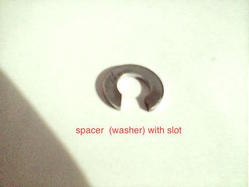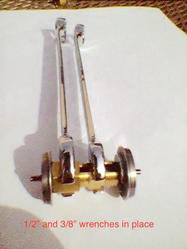The other night I was running a new consist on the layout and noticed two different cars I had just put up on the layout were arching and sparking going through the frog of the divergent track on my Atlas"O" 7.5 degree turnouts. The two cars in question just happen to be Lionel. One car had the late "hidden tab" mechanism installed and the other car had the previous thumbtack system on the die-cast sprung trucks (# 12843).
A few months ago I had purchased a digital caliper from Harbor Freight for uses such as this. When I started checking the wheel-sets that had the tell-tale "welding marks" on the inside of the wheel flange. I found the offending wheel-sets were "tight" by at least 0.0090" . (CORRECTION here: should be 0.090")
I dug out some brand new 12843 wheel-sets I had purchased years ago and found they were similar to the one wheel-set that did not have any issues. They measured about 1.0435" on average back-to-back. I installed two new trucks and had that car fixed. Note: These wheel-sets have staked side-frames to the bolster.
My next car was the "tab" diecast sprung trucks; these trucks are actually screwed together at the truck bolster. This allows you to deftly un-screw them to the point of being loose at which time you can spread them apart enough to work the axle out of the teflon bearings in the side-frames. Once I had them out, it was just a matter of putting the axle set on my vice and gently knocking the axle down through the wheel. Once it was loose, it was just a matter of taking a socket that fit inside the outside face of the wheel and re-installing it to my preferred dimension of 1.0435". Once done and re-assembled, that car is now problem free as well.
After this history, this brings me to my question which is; have any of you figured out a way to re-gauge the wheel-sets on the "staked side-frame" (#12843) die-cast sprung truck? Everything I have tried in the past invariably results in a bent axle, and sore fingers with no apparent change in wheel gauge. There is no way to wiggle the axle out of these trucks that I've found to date. Cutting the staked metal off the top of the bolster means you have nothing to re-stake or a method to retain the side-frame to the bolster unless one could drill into the side-frame and tap for a machine screw from the top (?)...
Awaiting any ideas you Forumites may have....












